6.7.6 Buffer tank sizing
At the planning stage it is important to consider whether a buffer tank will be needed to
prevent short-cycling. Repeated short-cycling can lead to premature compressor failure and
other component damage. Good practice is to design for a minimum cycle time of ten
minutes. To calculate the buffer tank size required:
where:
V= minimum volume of buffer tank (USgallons)
t = desired minimum cycle time (minutes); IBC recommends 10
Q = heat source output rate, i.e. minimum output (Btu/h)
q = lowest rate of heat extraction from tank: may be zero (Btu/h)
ΔT = tank differential (°F); IBCrecommends 10 and advises this should not exceed
20°F
Quick calculation for buffer tank sizing
6.7.7 Quick calculation for buffer tank sizing
The buffer tank volume in gallons can be quickly calculated by taking the minimum output in
MBtu/h and multiplying by two. (This presumes the tank temperature can vary by 10°F.)
where:
V= minimum volume of buffer tank (USgallons)
Q = minimum heat source output rate (Btu/h)
Example:if the Heat Pump's minimum output is 20MBH (read from the lowest modulation (30
Hz) chart), 20 X 2 = 40; thus the buffer tank's minimum size is 40 gallons.
